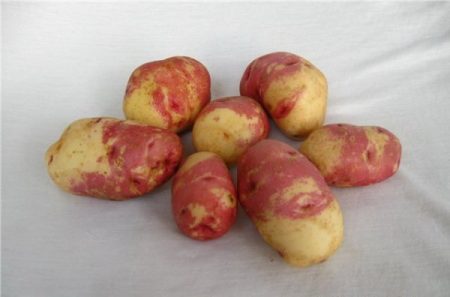
Potato "Ivan da Marya" is known to many gardeners. A description of the variety and photos are in our article. The ancestor of the Ivan da Marya variety was the Dutch Picasso potato. Effective coloring, excellent taste, unpretentiousness and high yield of the variety are the main advantages of this potato.Since 1995, this variety has been widely cultivated by vegetable growers in the central regions of the country. Potato varieties "Ivan da Marya" in the common people are called "Matryoshka", "Rowan", "Little Red Riding Hood". These names were invented due to the fancy color of tubers; there are many photos of this potato on the net. On the cut, the flesh is cream-colored, from the tubers of this variety excellent dishes are obtained.
Content
Description and characteristics of the variety
A bush of potatoes of the sort "Ivan da Marya" is straight with spreading shoots, leaves are large, dark green. Blooms profusely, cream-colored flowers. Tubers are round-oval in shape, yellow peel with pink patches. Eyes are small. The average tuber weighs about 120 grams. In one bush there can be up to 19 potatoes, which makes it possible to consider the variety as fruitful. The starch content is from 8 to 14%. Tubers have a good presentation, keeping quality reaches 90%.
The variety is resistant to a number of diseases and pests, including potato cancer, twist virus, nematode, late blight, scab. Potato Ivan da Marya belongs to the late-ripening varieties, 120-130 days pass from germination to ripening.
Advantages and disadvantages
The advantage of the variety is the smooth surface of root crops, the possibility of long-term storage. The variety "Ivan da Marya" tolerates drought, is resistant to major diseases. When cooking, potatoes are distinguished by excellent taste.
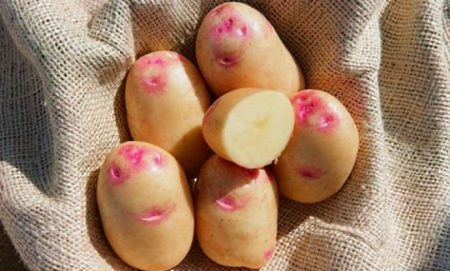
The disadvantage of this variety is the defeat of the Colorado potato beetle, as well as the tubers are gradually degenerating, therefore, every 4-5 years, the seed material is replaced with a new one.
Preparing tubers for planting
Germination is an important stage for the preparation of tubers. For the appearance of sprouts, seed potatoes in about 30 days are brought into a warm room. Stack tubers in a maximum of two layers. After a few days, the temperature is reduced to + 10-14 degrees, this is necessary so that the sprouts do not stretch.
Before planting, the tubers are carefully sorted, removing specimens with obvious signs of disease or with weak sprouts. Large and medium potatoes are cut into several parts. Do this about a week before planting in the ground, so that a protective layer has time to form. If there is no time, and you have to cut just before planting, the tubers with the cut side are dipped in wood ash or treated with the drugs "Maxim", "Sinclair", Celest-Top "," Switch ".
Landing Features
Potatoes of the Ivan da Marya variety are planted in late April or until May 10. The landing site is chosen open, sunny with light fertile land. The soil should be well-heated, slightly moist. Wells should be 10-12 cm deep. A handful of ash or onion husks are poured into the hole as an additional source of nutrition and protection from wireworms. The size between the holes is 30-35 cm, in the row spacing 70 cm.
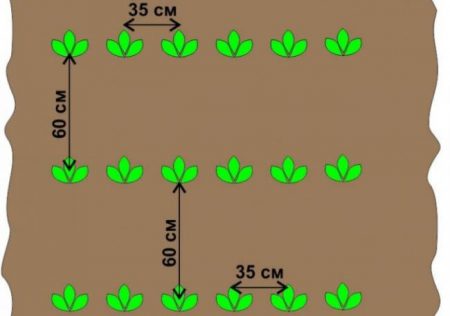
Care
Hilling. This procedure is carried out 10-12 days after germination. The soil is raked to the stem of the plant from all sides. The second hilling is carried out before laying the buds.
Watering.Although the variety is resistant to drought, watering is carried out before the first loosening and during the flowering period. Approximate water use 40 liters of water per 1 m².
Top dressing. Potatoes are fed in the second half of growth at the beginning of budding. For this, manure or humus is suitable. Enough 5 kg of fertilizer per 10 m², top dressing done on moist soil before hilling. As a natural fertilizer, you can use the green part of green manure, which is placed in the aisles and lightly embedded in the soil.
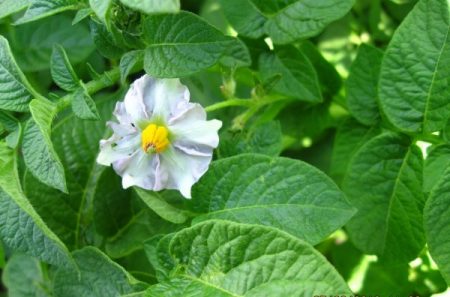
Disease
Striped mosaic. The disease occurs during the development of buds. Necrotic spots appear on the lower leaves. Affected leaves fall, the plant dies. Affected bushes are not treatable, therefore they are dug up and destroyed along with potatoes outside the site.
Virus twisting. With the disease, the upper side of the leaves turns yellow. Then the lower part becomes pink, the leaf begins to curl along the central vein. The plate becomes brittle. Ill bushes are subject to destruction.
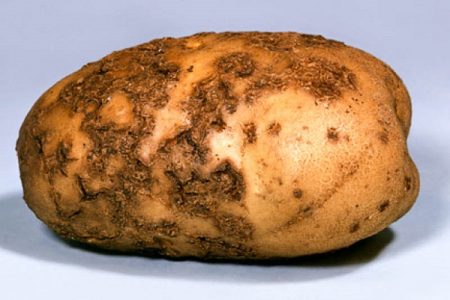
Fomoz. A diseased plant can be easily identified by an elongated spot that begins on the leaf petiole, and then passes to the stem. Affected parts of the stem die, spores of the fungus fall into the soil. Putrid dark spots appear on the tubers. For preventive purposes, planting potatoes three weeks after germination is treated with Shirlan or Thanos preparations. During flowering plants use fungicide "Ridomil Gold MC."
Pests
Colorado beetle. This insect is known to all gardeners, it is worth missing the moment of the appearance of larvae and planting potatoes can be destroyed in a matter of days. To preserve the crop, one of the following preparations, “Masterpiece”, “Prestige”, is used. It will reduce the number of the Colorado potato beetle and help decoction of wormwood, celandine or horsetail. To repel these insects, joint plantings of potatoes with beans, beans, calendula, marigolds are used.
Wireworm. The nutcracker beetle larva infects potatoes, gnawing numerous moves in the tubers. To scare away insects when planting, add onion husks to the hole, birch ash from the preparations, you can add Bazudin or Pochin, Zemlin. The nutcracker is attracted to weeds; it is at their roots that it lays eggs, from which larvae appear in a few days.
Potato Moth. The insect lays eggs on the inside of the leaf. After some time, caterpillars appear on them, which feed on the green part of plants and tubers. You can get rid of caterpillars using the "Cytocorum" or "Spark". To prevent the propagation of potato moths, pheromone traps are installed on the site.
Harvesting and storage
Tubers of the Ivan da Marya variety are harvested in mid or late August. It is better to choose a sunny day with warm weather. In order not to damage the tubers use a pitchfork. The dug potatoes are dried in the open air, then the crop is transferred to a cool, dry place. Before laying for long-term storage, potatoes are sorted out, removing damaged or with signs of disease tubers.
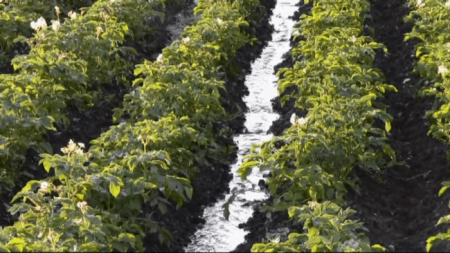
Potatoes are stored in the cellar at a temperature of 0 to +2 degrees, with a humidity of 80%. Tubers are stored in cardan boxes with slots, baskets or other containers. The boxes are located on a hill 20 cm above the floor and 30 cm away from the wall.
Reviews
Elena, 35 years old:
“Ivan da Marya potatoes are planted for the third season, the potatoes are very tasty, crumbly.It is not difficult to grow this variety, we only spud on time and water once during flowering. Harvest stored in the cellar at a temperature of 0 ° C, good preservation. "
Eugene, 47 years old:
“I purchased seeds of this variety two years ago, I want to note that the variety Ivan da Marya gives up to 19 tubers. After harvesting, I bring in manure and dig a plot, this top dressing works well on plants. I only water it twice a season, because the variety tolerates drought well. ”
Anna, 39 years old:
“Our soil is acidic, so in the fall we introduce dolomite flour and mineral fertilizers. Potato "Ivan da Marya" grows well, we plant marigolds and nails next to the beds, it turns out beautifully and useful, as Colorado beetles fly by. When landing in the hole, I lay humus and during the season I no longer feed. I was satisfied with the harvest, the taste of potatoes is excellent. ”




 Description and description of varieties in Belarus with a photo
Description and description of varieties in Belarus with a photo Do I need to pick flowers from potatoes: why do they do it
Do I need to pick flowers from potatoes: why do they do it When to dig potatoes: timing and availability of new potatoes
When to dig potatoes: timing and availability of new potatoes How to grow a good potato crop: various methods and methods, planting and care
How to grow a good potato crop: various methods and methods, planting and care